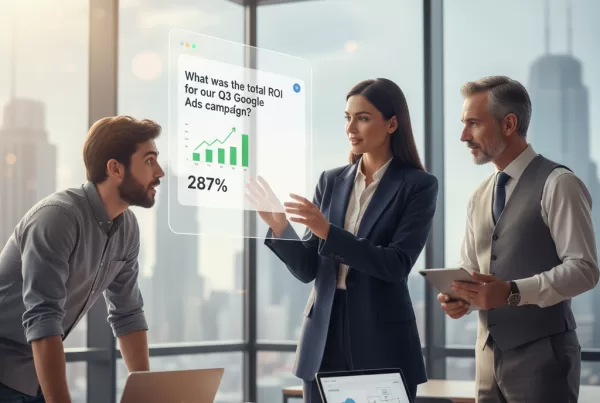Conversational AI to get timely Insights? Analyse Your Google Analytics 4 (GA4) Traffic Patterns with Context.
Executive Summary
In today’s data-saturated landscape, the critical challenge for leadership is not the volume of data but the velocity of insight. Traditional analytics dashboards, while powerful, often create a bottleneck, leaving time-poor executives dependent on specialist analysts to answer urgent business questions. The 2025 CMO Survey highlights this disconnect, revealing that 64% of marketing leaders find it challenging to demonstrate the financial impact of their actions, and 51.8% struggle to focus analytics on the most important problems. This article introduces a paradigm shift: an MCP (Server and Client) architecture integrated with Google Analytics 4 (GA4) to create a conversational AI (Chat interface). By layering Large Language Models (LLMs) on top of a clean, unified data stream managed by the MCP Server, we transform analytics from static reporting into a dynamic dialogue via the MCP Client. This allows CMOs, CEOs, and marketing managers to ask complex questions in natural language, such as “What was the customer lifetime value of users acquired from our Q3 campaign?”, and receive immediate, data-driven answers. This approach directly addresses the primary challenges facing modern leaders, accelerating decision-making, democratising data access, and finally closing the gap between marketing activity and proven financial value.
Introduction: From Data Overload to Strategic Dialogue with Conversational AI
The promise of data-driven marketing has always been clarity. Yet for many organisations, the explosion of digital touchpoints has led to the opposite: a complex web of dashboards, metrics, and reports that obscure more than they reveal. This “data accessibility gap” means that while we are collecting more information than ever, the ability to translate it into timely, strategic action remains elusive. Senior leaders, who need answers now, cannot afford to wait for manual report generation or spend valuable time navigating the intricate user interface of platforms like Google Analytics 4.
The solution lies in fundamentally changing our relationship with data. Instead of merely viewing data, we must learn to converse with it. The convergence of robust server-side data collection and the power of conversational Artificial Intelligence is making this possible. This evolution aligns perfectly with the future trajectory of AI in marketing, which is projected to grow from 17.2% usage today to over 44.2% in the next three years.
The Challenge: The Limitations of Traditional Analytics Dashboards
For all their capabilities, traditional analytics platforms present two significant hurdles for strategic leadership:
- The Data Fluency Barrier: Dashboards are designed for analysts. They require a specific skill set to navigate, segment, and interpret. This creates a dependency on a small group of specialists, slowing down the flow of information to key decision-makers like the personas we serve, from Luísa, the strategic Director of Marketing, to Afonso, the hands-on E-commerce Manager.
- The Speed-to-Insight Deficit: Answering a strategic question often involves a multi-step process: briefing an analyst, waiting for data extraction and analysis, and finally receiving a report. In a fast-moving market, this delay can mean the difference between capitalising on an opportunity and reacting to a crisis.
These limitations directly contribute to the top challenges identified in The CMO Survey, where leaders struggle to link marketing investments to business objectives and financial outcomes. The traditional model is no longer sufficient for the demands of agile, data-led leadership.
The Solution: The MCP (Server and Client) Architecture
A truly revolutionary approach requires a robust data foundation connected to an intelligent conversational layer. This is achieved by combining an MCP Server with a user-friendly MCP Client, powered by modern LLMs.
Explaining the MCP Server and Client
The definition of an MCP Server is simple yet impressive: it is the system that gives Large Language Models (LLMs) access to real-world context and capabilities. Think of an LLM like a brilliant strategist who has read every business book but has never seen your company’s actual sales figures or customer database. The MCP Server is the secure, backend bridge that provides the LLM with access to your proprietary file systems, APIs, databases, and other critical data sources that it cannot reach on its own. It operates on your server, ensuring high-fidelity data integration from your CRM, ad platforms, and website, creating a single source of truth.
The MCP Client is the other half of the equation: the user-facing application. This is the conversational interface, the ‘chat window’, where executives interact with the data via the LLM. The Client makes the immense power of the Server accessible to non-technical users.
Together, the MCP Server and Client create a seamless architecture for turning complex data into simple conversations, forming the foundation of a reliable Data-Driven Marketing Services strategy.
The Conversational AI Layer: From Clicks to Questions
Once your MCP Server is feeding high-quality, enriched data into GA4 and other systems, the MCP Client provides the conversational layer. Using powerful LLMs such as Google’s Gemini, Anthropic’s Claude, or models from OpenAI and Mistral, it creates a secure, internal “chatbot” for your company’s data.
Instead of navigating the GA4 interface, a CEO or CMO can ask using Conversational AI:
- “Show me the conversion rate for users from the UK versus Germany last month on mobile devices.”
- “Which three blog posts generated the most qualified leads in Q2?”
- “What are my top 10 landing Pages for September, by type of content and category ?”
- “What are my top priorities for looking at Google Analytics data?”
See video in https://www.youtube.com/watch?v=ab8eyS94OEw
The LLM interprets the natural language query, the MCP Server retrieves the necessary data from GA4 and other connected sources, and the MCP Client provides a clear, concise answer, often with a simple chart or summary.
The IDIRA Framework in Action: A Practical Walkthrough
This entire process is perfectly encapsulated by the IDIRA Marketing framework, which provides a structured path from raw data to intelligent action.
- Integration of Data: The MCP Server serves as the core integration engine. It unifies customer data from your CRM, transaction data from your e-commerce platform, and behavioural data from your website, creating a single, comprehensive customer view.
- Data Collection: We must ensure that the data collection becomes more accurate and resilient, bypassing common issues like ensuring compliance with privacy regulations. This step ensures the insights are based on sound data.
- Insights: This is where the conversational MCP Client shines. The ability to ask direct questions transforms the process of generating insights from a time-consuming analysis into an instant query-and-response loop.
- Reports: The natural language answer provided by the LLM via the Client is the report. It is delivered in real-time, tailored precisely to the executive’s question, and stripped of unnecessary complexity.
- Artificial Intelligence: The LLM is the engine driving this new interface. It leverages the power of Artificial Intelligence in Marketing to understand context, process requests, and synthesise data into strategic intelligence.
Conclusion: The Future of Analytics is a Conversation
The shift from dashboards to dialogue represents more than just a technological upgrade; it is a cultural transformation. It democratises access to data, empowers strategic leaders to make faster, more informed decisions, and firmly establishes marketing’s role as a driver of financial growth. By implementing an MCP (Server and Client) architecture integrated with Google Analytics, organisations can finally overcome the data accessibility gap. This approach makes analytics intuitive, immediate, and directly aligned with the most pressing business questions, turning data from a complex resource into a trusted strategic partner.
We just launched IDIRA.chat, our solution that takes into consideration our Framework IDIRA and Your Data, Your Way
References:
- Model Context Protocol https://www.anthropic.com/news/model-context-protocol
- The CMO survey: Topline report 2025. https://cmosurvey.org/results/
Frequently Asked Questions (FAQs)
- How is this different from using the standard Google Analytics 4 interface? The primary difference is accessibility and speed. While GA4’s interface is powerful, it requires specialised knowledge. The MCP Client provides a conversational interface that eliminates the learning curve, allowing any authorised executive to get answers to complex questions instantly using natural language.
- Is this approach secure, especially with sensitive company data? Yes. The MCP Server operates within your controlled environment. Data is collected and processed on your own server before being forwarded to the necessary endpoints. The conversational AI layer (MCP Client) can be deployed securely, ensuring that queries and data remain private and are not used to train public models.
- What level of technical expertise is needed to use this system? For the end-user interacting with the MCP Client, no technical expertise is required. The interface is as simple as using a chat application. However, the initial setup of the MCP Server and its integrations requires specialised knowledge from a partner skilled in Google Analytics 4 Services.
- Can the MCP Server connect to data sources other than Google Analytics? Absolutely. A key benefit of the MCP Server is its function as an integration hub. It can collect and unify data from your CRM, advertising platforms, offline sales records, and more. This allows your MCP Client to answer questions that span your entire business ecosystem.
- How does this directly help in proving the Return on Investment (ROI) of marketing? This system is built to answer financial questions directly. Leaders can ask the MCP Client, “What was the ROI for our ‘Summer Sale’ campaign, considering ad spend and the total revenue generated from attributed sales?” The MCP Server retrieves the necessary data, the LLM performs the calculation, and the Client provides a direct answer, addressing the number one challenge for marketing leaders.





